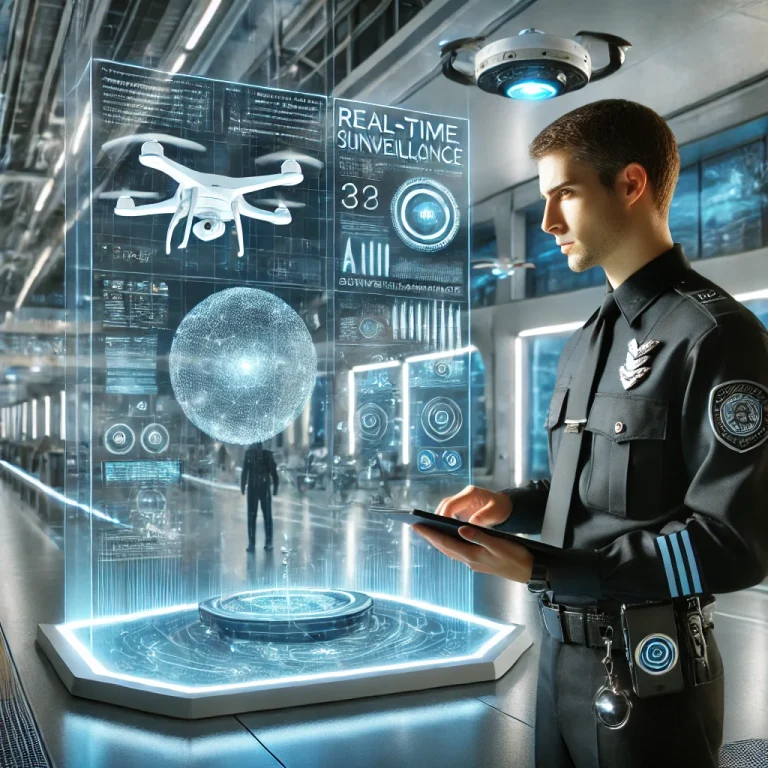The Future of Security: A Blend of Strategy and Technology

As we close out the year, this final article for 2024 offers a moment to reflect on what we’ve achieved and to turn our focus toward the future of security and the opportunities ahead.
The end of the year is a natural time to consider how we’ve grown and what lies on the horizon.
With that in mind, we thought it was the perfect time to look at the future of the security guard industry—a field that’s rapidly evolving and reshaping itself to meet the challenges of tomorrow.
“Technology is best when it brings people together.”
This sentiment rings especially true in security, where innovation is transforming the way professionals work, think, and safeguard our world.
From new tools to refined strategies, the industry is moving in exciting directions.
Let’s explore these shifts in detail to understand what the future holds and how we can prepare for it.
The Role of the Modern Security Guard
The role of a security guard has shifted significantly over the years.
Once seen primarily as passive observers or deterrents, today’s guards are active contributors to safety and security strategies.
Their responsibilities differ greatly depending on the environments they serve.
In retail, for example, guards often handle high-pressure situations involving theft prevention, customer disputes, or even emergency evacuations.
Their ability to stay calm, engage tactfully, and respond decisively makes them invaluable.
Contrast this with construction sites, where the focus is more on perimeter control, safeguarding expensive equipment, and deterring unauthorized access.
In healthcare facilities, the role becomes even more dynamic, requiring a delicate balance of empathy and authority to handle patients, visitors, and medical staff.
This adaptability is what defines a successful modern security guard.
The ability to engage directly with their surroundings and connect with people sets great guards apart.
In the future of security, guards who take proactive steps—whether greeting visitors, asking questions, or conducting thorough patrols—create a visible presence that both reassures and deters.
This active participation turns a routine job into a fulfilling, impactful career while significantly enhancing the security of the environments they serve.
How Technology is Changing the Game
Technology has become a game-changer in nearly every industry, and security is no exception.
Many repetitive or routine tasks that once required constant manual attention can now be supported—or even replaced—by automation.
This shift allows guards to focus their energy on tasks that require critical thinking, situational awareness, and human interaction.
Advanced CCTV systems with built-in analytics are a prime example.
These tools monitor vast areas in real time and flag unusual activity, such as unauthorized access or prolonged loitering.
In the future of security, guards no longer have to monitor endless streams of footage manually.
Instead, they can respond to alerts, assess the situation quickly, and take appropriate action.
This makes their work more efficient and ensures no critical detail goes unnoticed.
Mobile reporting tools are another key advancement.
They allow guards to document incidents immediately, complete check-ins, and share updates with their teams.
When combined with centralized data systems, this documentation enables predictive analysis.
Patterns can be identified, and resources can be deployed more effectively to address recurring risks.
Guards equipped with these tools are better informed, better prepared, and more effective in their roles.
However, technology isn’t a replacement for human judgment.
It’s a support system, ensuring that guards can work smarter, not harder, and focus on their core mission—keeping people and property safe.
The Foundation of Effective Security: Risk Assessment
No security plan is complete without a thorough risk assessment.
This foundational step identifies what is most at risk, the specific threats to that risk, and the vulnerabilities that might be exploited.
For security to be effective, it must be tailored to these unique factors.
A one-size-fits-all approach simply doesn’t work in today’s complex environments.
For example, in a residential building, the primary risk might be unauthorized entry.
A tailored strategy might involve a combination of keycard access, 24/7 patrols, and real-time visitor monitoring.
In contrast, a corporate office with valuable intellectual property might prioritize cybersecurity alongside physical security measures such as access control systems and surveillance cameras.
Risk assessments aren’t a one-time task.
As environments, technologies, and risks evolve, so too must security strategies.
Regular reviews ensure that vulnerabilities are addressed promptly and that security programs remain relevant.
This ongoing process allows organizations to adapt to emerging challenges, ensuring their assets and people remain protected.
Blending Human Intuition with Tech Solutions
Despite the rise of technology, the human element remains irreplaceable in security.
Machines can process data, monitor patterns, and provide alerts, but they can’t interpret emotions, de-escalate conflicts, or build trust.
These are uniquely human abilities, and they’re often the most critical in high-stakes situations.
For example, inn the future of security when an AI system flags an unusual activity, a human guard must assess whether it’s truly a threat or an innocent anomaly.
Context matters and no algorithm can account for every nuance.
Similarly, in an escalating situation, a calm and empathetic human presence can defuse tensions in a way no machine ever could.
The future of security lies in balancing these two forces.
Guards should rely on technology to handle the mundane—scanning, monitoring, and reporting—while focusing their efforts on what they do best: engaging with people, interpreting complex scenarios, and making informed decisions.
This partnership between humans and technology creates a future of security that is both efficient and deeply effective.
Final Thoughts
As the year comes to a close, it’s clear that the security industry is poised for significant growth and transformation.
Guards are no longer just a visible deterrent; they are strategic professionals supported by advanced tools.
By combining thorough risk assessments with innovative technologies, the industry can adapt to emerging threats while maintaining the human touch that is so vital to safety.
The future of security guarding is bright, but it requires adaptability, engagement, and a willingness to embrace change.
As we look ahead, let’s commit to building security programs that don’t just react to risks but anticipate them.
Here’s to a safer, smarter, and more innovative new year!
Last Updated on Dec 9, 2024





